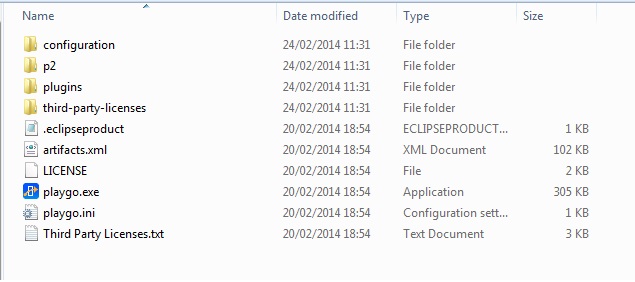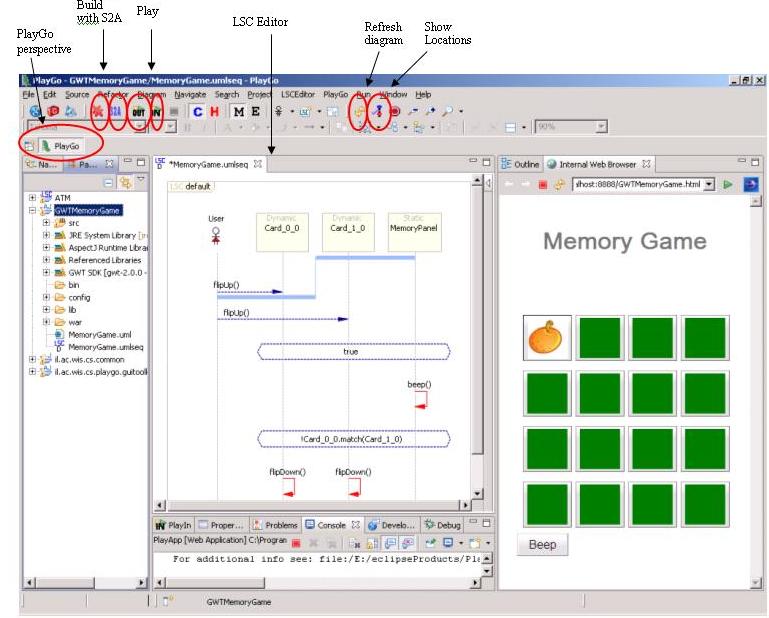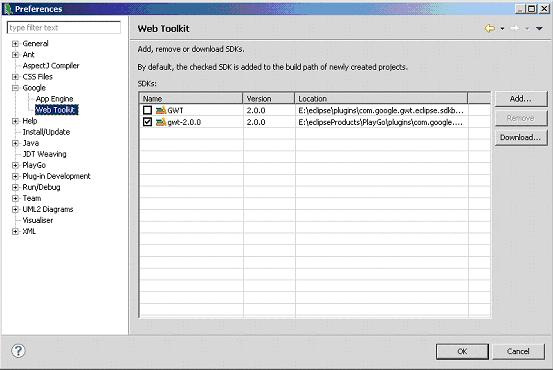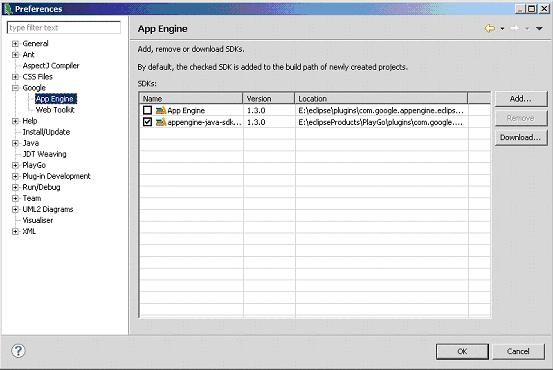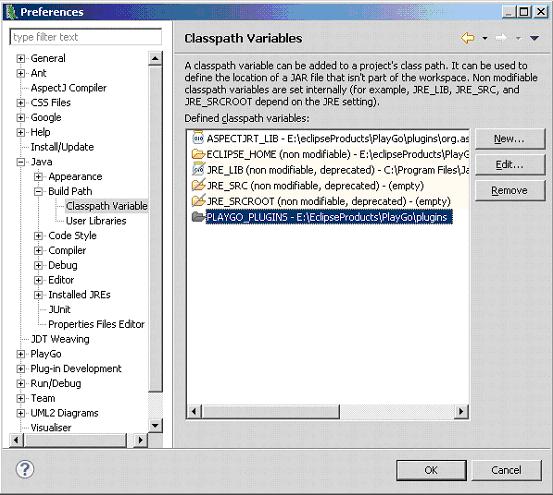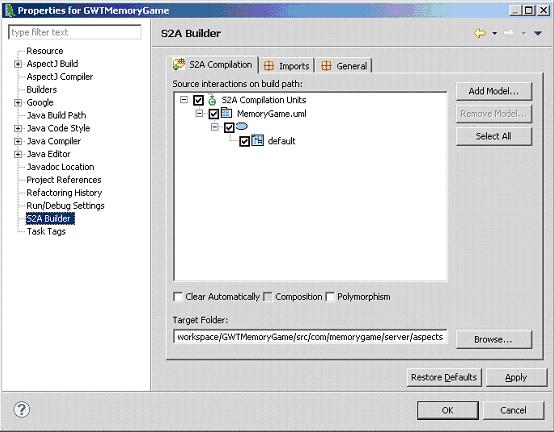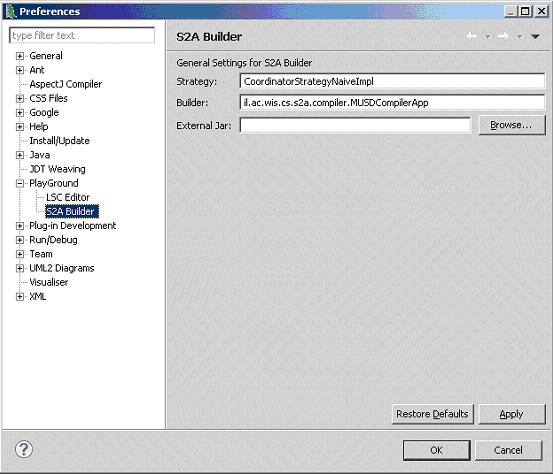Difference between revisions of "Getting Started with PlayGo"
(→Troubleshoot) |
(→2. Enrich the Examples with More Scenarios - Play-in) |
||
| Line 116: | Line 116: | ||
=====Troubleshoot===== | =====Troubleshoot===== | ||
If play-out does not execute your newly created scenarios, try to re-load your modified model. This can be done by right clicking your project and selecting Properties --> S2A Builder. Remove the existing model by choosing it and clicking the 'Remove Model' and add the modified model, by clicking the 'Add Model' button and choosing the modified model. | If play-out does not execute your newly created scenarios, try to re-load your modified model. This can be done by right clicking your project and selecting Properties --> S2A Builder. Remove the existing model by choosing it and clicking the 'Remove Model' and add the modified model, by clicking the 'Add Model' button and choosing the modified model. | ||
| + | |||
| + | =====How To...===== | ||
| + | Playing-in in PlayGo is sometimes a cumbersome task (and we are working on improving it). Below are some instructions for playing-in: | ||
| + | * Clicking an object in the GUI creates a diagram snippet reflecting that | ||
| + | operation | ||
| + | * Use the Play-In toolbar icon to control some of the Play-In operation, such as: | ||
== Create your First LSC Project == | == Create your First LSC Project == | ||
Revision as of 14:18, 6 September 2010
Install PlayGo
PlayGo is based on Eclipse and is packaged and provided as Eclipse Product. In addition to the product itself we provide a workspace with few examples.
To install PlayGo, create a new directory and extract the PlayGo.zip file to that newly created directory. Throughout this document we will refer to this directory as <PlayGo>.
Once extracted, your <PlayGo> directory should have the following content:
JRE Configuration
Open the <PlayGo>/PlayGo.ini file and update the Java VM path to: <PlayGo>\ jre6\bin\ (e.g. D:\PlayGo\jre6\bin\). Alternatively, if you have Java 6 installed on your machine, simple remove the '-vm' parameter from the <PlayGo>\PlayGo.ini file. PlayGo will use your System properties to access your installed Java.
Run PlayGo with the Provided Workspace
Startup PlayGo
To start PlayGo, go to your <PlayGo> directory and double click the PlayGo.exe file. As it is in Eclipse, PlayGo will ask you for the workspace to start with. Choose the workspace provided with the installation (i.e. <PlayGo>/workspace/).
The <PlayGo>/workspace/ contains 4 projects:
- ATM – example for ATM System. The ATM GUI side is based on GWT. ATM behavior was modeled by Playing in a set of scenarios. S2A is used for generating aspects, which are used to monitor and run the system (Play-Out).
- GWTMemoryGame – Another example system. The Memory Game GUI side is based on GWT. Its behavior was modeled by Playing in a set of scenarios. S2A is used for generating aspects, which are used to monitor and run the system (Play-Out).
- il.ac.wis.cs.common – a library which contains few examples for creating LSC models by coding in Java.
- il.ac.wis.cs.playgo.guitoolkit – a platform library used by the ATM and GWTMemoryGame. This is integral part of PlayGo and in the future will be provided as a jar file only.
We will refer to these projects in the following chapters.
Once PlayGo is open, note that the PlayGo perspective is selected. It is recommended to use this perspective, as it provides some shortcuts.
Configure the Examples
Before you can compile and run the examples, you need to configure them:
1. From Window menu, choose Preferences->Google->Web Toolkit. Configure it to point to your <PlayGo>\plugins\com.google.gwt.eclipse.sdkbundle.2.0.0_2.0.0.v200912062003\gwt-2.0.0 directory:
2. From Window menu, choose Preferences->Google->App Engine. Configure it to point to your <PlayGo>\plugins\com.google.appengine.eclipse.sdkbundle.1.3.0_1.3.0.v200912141120\appengine-java-sdk-1.3.0 directory:
3. From Window menu, choose Preferences->Java->Build PathClasspath Variables. Edit the PLAYGO_PLUGINS variable to point to your <PlayGo>/plugins/ directory:
4. Basically the examples provided are configured with relative paths and should work well in your environment, but this is a good opportunity to introduce some parts of the configuration you can control. Right click the GWTMemoryGame project->Properties->S2A Builder:
As shown in the screenshot above, there are 3 tabs in which you can configure properties related to S2A:
A. S2A Compilation
i. Here you can add and remove models which you want to compile with S2A.
For those models you add, you may choose which LSCs should be compiled by S2A. In other words, for which Interactions S2A will generate aspects.
ii. Target Folder: here you specify the directory in which the generated aspects will be located.
iii. Clear Automatically – if on, cleans the aspects directory before generating new aspects.
iv. Polymorphism – enable or disable polymorphism.
B. Imports
i. Here you may specify packages that will be imported in the generated aspects.
ii. Output package name – the package of the generated aspects.
C. General – currently used only for specifying the log4j configuration location.
5. S2A preferences – Advanced From the Windows menu, select Preferences->PlayGo->S2A Builder
Here you can choose the strategy you want to activate. Currently the only strategy implemented is the Naive strategy and this is the one being used.
What You Can Do with the Provided Workspace
1. Run the Examples - Play-out
The provided examples are configured and ready to be Played-out. Aspects are already generated and Java-compiled. To Play-out, select an example project (e.g. GWTMemoryGame) and click the 'Play-out' button on the toolbar. As a result the Play-out server will start, the corresponding GWT application will start and its URL will be copied to the Eclipse Internal Web Browser.
To Stop Play-out click the 'Stop' button on the toolbar, next to the 'Play-out' and 'Play-in' buttons.
Troubleshoot
If the example doesn’t seem to work, it is recommended to compile it and then re-try. For compiling it, select the example project and click the 'GWT Compile Project' button on the toolbar.
- If the problem persists, you can select the example project --> right click
it and choose 'Debug as LSC'. This has the same effect as clicking the 'Play-out' button on the toolbar, but it sometimes works better…
- If the problem persists, make sure aspects were generated. To generate aspects, you should follow these steps (these steps should be done automatically by the 'Play-out' action when clicking 'Play-out' button on the toolbar):
- Select the project you want to play-out.
- Press the 'Build with S2A' icon in the toolbar or right click and chose 'Build with S2A'.
- Refresh the project directory, to make sure Eclipse loaded the newly generated aspects.
2. Enrich the Examples with More Scenarios - Play-in
For playing-in, select an example project (e.g. ATM) and click the 'Play-in' button on the toolbar. As a result the play-in server starts, the corresponding GWT application starts and its URL is copied to the Eclipse Internal Web Browser.
You can now start playing-in.
Note: For adding new LSC(s) to existing specification, open the specification file (the .umlseq file) prior to starting the play-in process.
Troubleshoot
If play-out does not execute your newly created scenarios, try to re-load your modified model. This can be done by right clicking your project and selecting Properties --> S2A Builder. Remove the existing model by choosing it and clicking the 'Remove Model' and add the modified model, by clicking the 'Add Model' button and choosing the modified model.
How To...
Playing-in in PlayGo is sometimes a cumbersome task (and we are working on improving it). Below are some instructions for playing-in:
- Clicking an object in the GUI creates a diagram snippet reflecting that
operation
- Use the Play-In toolbar icon to control some of the Play-In operation, such as:
